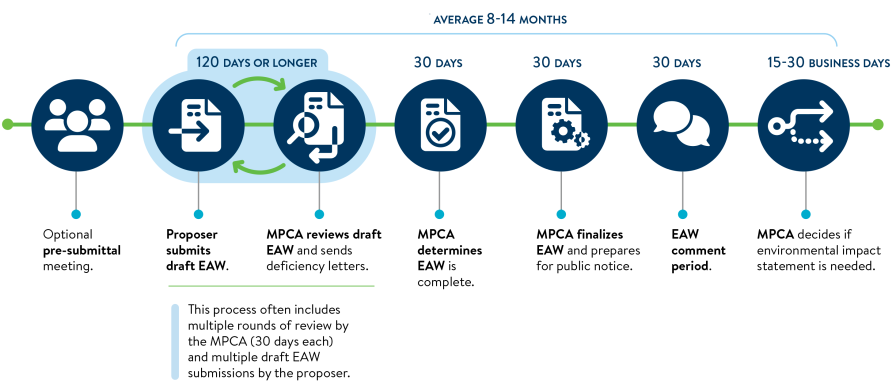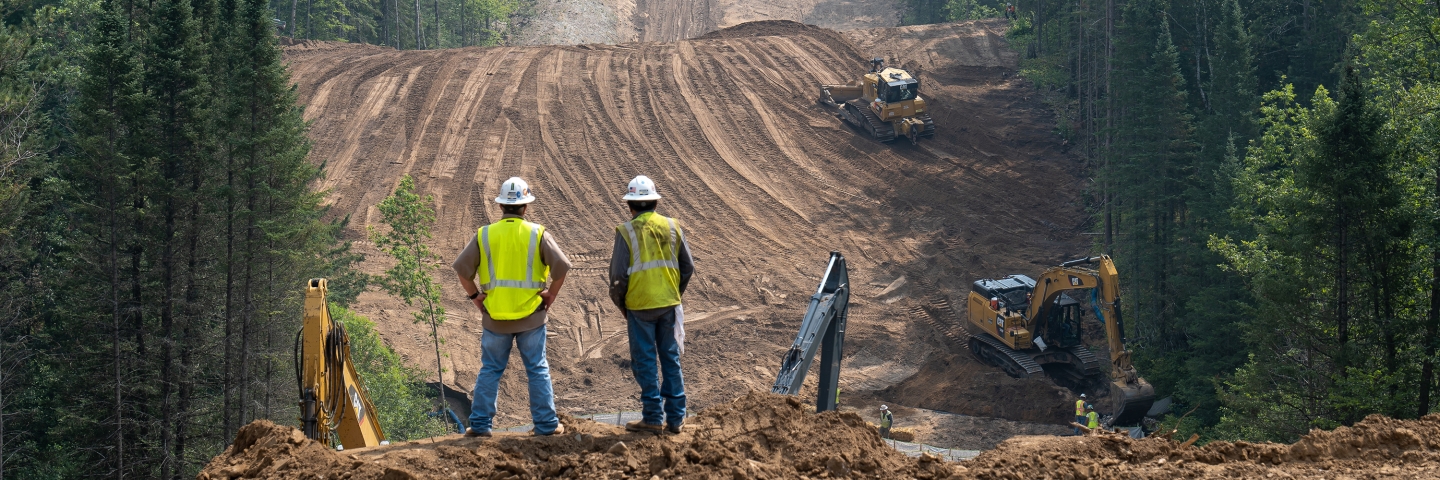Certain proposed projects — based on their nature, size, location, or other factors — must go through an environmental review before any required permits or approvals are issued. Minnesota Rules parts 4410.4300 and 4410.4400 list the types of projects that require environmental review. The Environmental Quality Board (EQB) oversees environmental review in Minnesota.
Environmental review is NOT an approval process; it's an information-gathering process intended to:
- help public agencies make informed permitting and approval decisions
- give the public access to decision makers
- ensure public awareness and meaningful input into decision-making
The most frequently used types of environmental review are:
- Environmental assessment worksheet (EAW) — a brief document designed to lay out a project’s basic facts and assess its potential for significant environmental effects, which determines if an environmental impact statement is required. The MPCA uses the EAW, written comments received, permit applications, and other relevant information to decide if an EIS should be ordered. The MPCA Commissioner makes the final decision, documented in a “Findings of Fact, Conclusions of Law and Order.”
- Environmental impact statement (EIS) — an in-depth review of projects with potential for significant environmental effects. An EIS provides detailed information about the extent of potentially significant project environmental impacts, presents alternatives to the project, and identifies methods for reducing adverse environmental effects.
An EAW and EIS describe a project, its potential effects on air, land, and water resources, and ways to reduce negative environmental effects. When the review identifies unacceptable environmental impacts, the project's proposers can make changes. The information is also used to establish permit conditions that will protect our environment.
Learn more about environmental review and how to provide input on MPCA's processes:
Role of responsible government units
Responsible government units (RGUs) are the government entities — such as counties, cities, or state agencies — responsible for preparing the environmental review documents. For mandatory reviews, the RGU is typically the permit issuer and is listed in Minnesota Rule. For other cases, the EQB selects the RGU.
If the RGU or project proposer decides a project not listed under EQB rules has the potential for significant environmental effects, the project must go through the environmental review process before it may proceed. Residents may petition the EQB to request an EAW on a project.
Does your project need environmental review?
Use this pre-screening form to determine if your project needs environmental review by the MPCA:
Pre-application meetings are strongly encouraged and provide an opportunity to discuss the project with MPCA staff to determine environmental review needs and timeline. If you think your project requires review, request a meeting with the MPCA early in the project planning.

Draft EAW
The project proposer is responsible for gathering information about the project’s potential environmental effects and ways to avoid or minimize them. No permits or approvals (local, county, or state) may be issued until environmental review is complete. MPCA's environmental review and permitting staff work together to ensure consistency and coordinate public notices. Permit applications must be submitted prior to or at the same time as the draft EAW. The key components guidance document reviews this in greater detail.
The draft EAW must include:
- a county map showing the general project location
- a topographic map showing project boundaries
- a site map that clearly identify existing operations/structures (if present) and the proposed operations/structures
- greenhouse gas information: Greenhouse gas quantification and assessment, climate change adaptation and resilience information (EQB)
- additional information if your project is located in an environmental justice area
Standard EAW form and guides:
- Environmental assessment worksheet form, revised Dec. 2022 (EQB)
- EAW guidelines - Preparing environmental assessment worksheets (EQB)
Animal feedlot EAW form and guides:
- Alternative EAW form for animal feedlots (EQB)
- See guidance from Standard EAW
Submit the draft EAW to MPCA’s general Environmental Review email at env.review.pca@state.mn.us, or directly to an MPCA Environmental Review staff member you have contacted.
Coordinated project plan
A coordinated project plan (CPP) is a plan and schedule to ensure environmental review and associated required state agency actions are completed efficiently by coordinating and establishing deadlines for all necessary state agency actions (Minn. Session Law - 2024, Regular Session).
A coordinated project plan includes:
- a list of all state agencies known to have environmental review, permitting, or other regulatory authority over the eligible project and an explanation of each agency's specific role and responsibilities for actions under the coordinated project plan
- a schedule for formal public meetings
- a comprehensive schedule of deadlines by which all environmental reviews, permits, and other state agency actions must be completed. The deadlines established must include intermediate and final completion deadlines for actions by each state agency and must be consistent with required deadlines, subject to modification in accordance with Minnesota Statute
Petition for EAW determination
A petition is a way the public can provide evidence to government entities to demonstrate that a project may have the potential to have significant environmental effects. Members of the public can petition for projects that are not already required to complete an environmental review. The petition requires 100 signatures of individuals who live or own property in Minnesota. After reviewing evidence provided in the petition, a decision is made whether or not environmental review will be required for the project.
More information
- visit our Public comment page to review any projects open for public comment
- for information requests, such as past environmental review documents, contact MPCA's Records Management Unit
